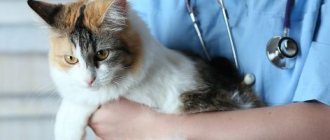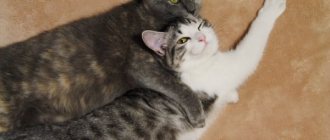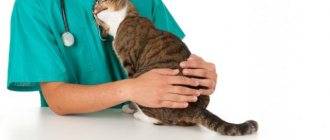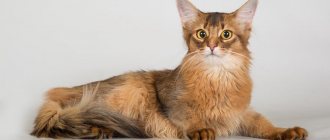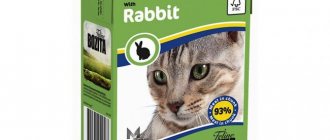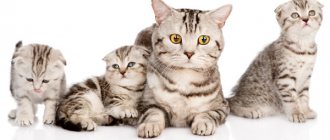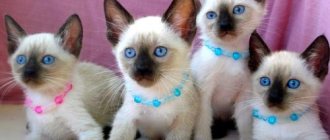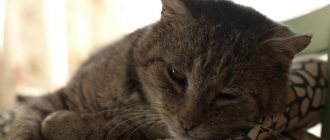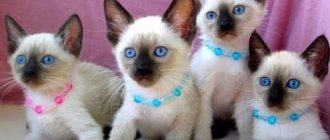How cat shows are held – 3
Registration for an exhibition, distribution of cats by exhibition classes
To participate in a cat exhibition, you need to find in the schedule of exhibitions using the WCF system the one that suits you by date and location. Club organizer m.b. any, but the exhibition must be held according to the WCF system. If you are already a member of any club, just in case, check with the head of your club whether your cat’s grades and titles for this exhibition will be counted. Then you need to submit a preliminary application for the exhibition and pay the exhibitor fee. At most exhibitions, registration is only preliminary.
To participate in exhibitions, all cats are divided into breed groups, then by breed, by color, and by exhibition class. Cats belonging to the same breed, color, gender and show class are compared with each other. Thus, competition and comparison for ratings and titles at the exhibition takes place between animals of the same breed, the same color, the same exhibition class, and the same sex. Division into colors - classes - sex exists in every breed. The difference is that some breeds can have many colors (PER, BRI, ORI, MCO), while others have fewer or even one (RUS - blue, BOM - black). Groups of breeds and breeds that belong to them:
• Longhair group (LH, LH): PER
• Semi-longhair group (SLH, SLH): SIB, MCO, NFO, RAG, NEV, SBI, ТUA, SOM, KBL, BLH, SFL
• Shorthair group (KS, SH): ABY, BEN, BRI, BUR, EUR, RUS, SFS, SCS, SIN, EUR, KBS, CRX, DRX, SPH, EXO
• Siamese-Oriental group (SO, SOSH): MBT, ORI, SIA, PBD, THA
At some exhibitions, a fifth group is introduced - hairless cats (if there are more than 15 representatives of the breeds at the exhibition: Canadian Sphynx, Don Sphynx and Peterbald). Exhibition classes: • a litter of three kittens aged from 10 weeks to 3 months without a mother cat – this is Litter class • a kitten from 3 to 6 months – kitten class (Kitten) • a kitten from 6 to 10 months – junior class (Junior) • cats from 10 months and older are considered adults and compete in the open class (CAC) • champion class (CACIB) • international champion class (CAGCIB) • grand international champion class (CACE) • European champion class (CAGCE) • class big European champions (CACM)
Learn more about WCF exhibition classes >>>>>>
Based on requests from future exhibition participants, a catalog is compiled where cats are recorded in a certain order - by breed, color, show class and gender. Usually the exhibition catalog is prepared no later than a week before the exhibition. Therefore, if you want your pet’s name to be included in the catalog, then hurry up
This is especially important for cat owners. This is free advertising for your cat.
Each cat is assigned a specific number in the catalog under which it will participate in judging. This number will be indicated on her cage, diploma and evaluation sheet. Cats at an exhibition are placed in special exhibition cages, and an exhibition number is attached to the cage. The same number must be permanently attached to the owner's clothing so that judges and spectators can easily understand which cat they are seeing at the moment. To the exhibition page of KLK “Moscow” Schedule of cat shows according to the WCF system in Moscow and nearby cities
Collecting things for the pet
Your cat will need a cage at the show. Better buy your own. This way the pet will be comfortable among unfamiliar people and animals. A cage that smells like home will help your pet feel more confident at an event.
Bring a curtain to cover the cage. It will protect your pet from drafts, other exhibitors, and keep the cage warm.
In addition, your cat will benefit from:
- toilet and filler;
- bowls for food and water;
- food and water;
- comb;
- toys.
We've sorted out the documents and things, now we need to prepare the pet itself. To ensure your cat looks perfect at the show, take care of its physical condition and beauty in advance. A few weeks before the exhibition event, adjust your pet’s diet, add vitamins for coat and skin, and do grooming.
Record
So, how to get to a cat show? The easiest way is to contact the breeder from whom you purchased the kitten. If this is not possible, you need to call your local club or go to the WCF website to find out the schedule. You can choose another system, but most exhibitions in Russia and neighboring countries are held by WCF - World Cat Federation.
Now all that remains is to choose a date, not forgetting to clarify the details: the address of the pavilion, the start time, whether a tent will be needed for the cat exhibition or whether the organizers will provide cages for the participants to house the animals, how the fee can be paid. Usually the organizers provide the account number to which the transfer needs to be made. In addition, you can pay for participation in a local club. If you are interested in how much a cat show costs, check this point in advance. As a rule, the amount ranges from 800 to 2000 rubles, depending on the rank of the event. Typically, the exhibitor fee can be paid directly on the day of the exhibition, which should also be inquired about in advance.
Since only registered competitors can participate in the cat show, you will need to provide the organizers with some information: age, breed, gender, color, etc. If you communicate by phone, the operator will ask all the necessary questions. If you fill out an application in writing, simply check the pedigree and enter the data as it is written in the document, without distorting the nickname, color, etc. Now your pet is registered, his and your data will be included in the catalog. In addition to personal data, at the registration stage you need to select a class. According to the WCF system, there are more than twenty classes: kittens, juniors, open class, international champion and so on. If this is your first cat show, and your pet is already ten months old, you need to enroll in an open class. This means that the cat will compete for the title “Champion” with other animals of the same breed and sex, but she can only get it (close) by receiving three CACs from three different experts at three different exhibitions (CAC - Candidate for Champion).
In addition to the examination, you can sign up for a special breed show and ring. Monobreed is an open selection of the best animals within one breed. The ring is an open judging where an expert selects the ten best animals in the exhibition, regardless of gender and breed, and distributes ten places among them. Titles at cat shows can only be obtained by passing an examination in your class, and victory in the ring or in a special breed is a flattering title, prestige, advertising, valuable gifts and simply bright emotions, comparable only to participation in Beste (which will be discussed below ).
Grooming
On the day of the exhibition they do grooming. The goal is to give the coat volume and shine, protect it from electrification and pollution, and make the pet appear in ideal form.
In the morning, the cat is combed against the grain, having previously been treated with an antistatic agent, exhibition foam or powder.
As a result, the animal’s fur should be soft to the touch and fall off gently.
Important! It must be remembered that excessive coloring and the use of powder on the animal will result in disqualification.
After the exhibition, it is necessary to bathe the cat again to wash off all the drugs from it.
How to behave at a cat show
Well, here it is, the cherished day “x” has finally arrived, you took the documents, everything you needed according to the list given above, and most importantly, you took your cat with you. You are full of enthusiasm and are in anticipation of the expected victory. We can wish you good luck and victory. But before we start congratulating you on them, you will need to show yourself on the positive side of your participation in the exhibition. Therefore, now we will tell you what you should do and how.
Registration of cat show participants
Your participation in the exhibition begins with your registration. To do this, go to the registration desk and receive the exhibition catalog and an envelope with a registration number. Please check that the information entered in these documents is correct. One mistake can cast doubt on the fact that your cat is the cat that is participating in the show. Therefore, be careful.
Veterinary control
Next to the receptionist's desk there is a veterinary control desk. Here you will need to provide the cat’s veterinary passport, a certificate from the veterinarian, and show the animal itself
Attention - you should not put a cat on a table that has not been treated with a disinfectant before you. If the veterinarian does not do this for some reason, bring this to his attention.
You have the right to refuse to risk the health of your animal. Although, some exhibitors in this case prefer to clean the table themselves or use a disposable diaper for inspection.
Choosing a seat in the hall
If you yourself have the opportunity to choose the location of your tent, choose, if possible, places not far from the judging tables and the ring, and make sure that there are no drafts or too noisy there. After this, you can lay out your things and begin to directly prepare the cat for participation in the exhibition and for judging.
Call to the judge's table
After the examination begins, expect to be called to the table. During the examination, watch yourself and the animal. Showing your dissatisfaction with anything or anyone is not worth it. Be prepared to also go through a comparison process if necessary.
Participation in additional events
All kinds of competitions, fashion shows and other entertainment programs should be considered for participation only if the animal does not experience discomfort from all this.
Winners Award
The most exciting moment is that if you have prepared correctly for the cat show, taken care of the healthy and attractive appearance of your pet, then it is likely that your cat’s name will appear on the list of winners. We sincerely wish this for you.
Video about the cat show:
The washing process consists of equally important steps:
- Preparation for washing (where to wash, what to wash with, what to wipe with, dry, comb, water, sprinkle, spray).
- Preparing the animal (claws, fur, ears).
- First soaping (the goal is to clean problem areas).
- Second soaping (the goal is to degrease the wool).
- Third soaping (the goal is show coat condition).
- Fourth soaping (the goal is to emphasize the advantages of the coat color). At this stage, antistatic agents and conditioners that add volume, shine, and silkiness are used.
- Final rinsing.
- Drying - grooming.
Place for washing. This can be a basin so deep that the cat's entire body is submerged in water. Remember: after each soaping, 3-5 rinses are necessary, which should not be neglected, so the location of the basin is very important so that the procedure of draining and collecting water is not too tiring for your animal.
It is convenient to wash the cat directly in the washbasin, if its size allows, in this case there are no problems with changing the water.
Place everything you need while washing so that it is within your reach and out of your cat's reach.
Preparing the cat. Trim her nails. Gently clean the ears to make them look smaller, pluck the tufts on them (not for all breeds! See Standard). Pluck tufts of hair in the form of “horns” between the ears.
Comb your cat with a wide-toothed comb to remove tangles; areas under the arms, collar, pants, and belly require special attention. Gently comb the tail.
Place cotton balls in your ears to prevent water from getting into them while washing your hair.
Remember that your animal is nervous, because he is facing a difficult and unpleasant test, so be calm and affectionate, do not fuss, your movements should be confident and unhurried. Talk to your cat, don’t forget that she feels more confident when she has support under her feet.
It is very good if you have an assistant who will hold it.
First soaping. After thoroughly wetting the animal's fur, lather the most contaminated areas (behind the ears, chin, paws, pants, base of the tail, at the location of the gonad). At this stage, use a product to degrease and deep clean wool. For these purposes, many use degreasing and whitening shampoos from well-known and proven companies producing cosmetics for animals, “House of An-Zhu”, “8 in 1”, etc., specially designed for especially contaminated wool and washing problem areas. Often owners of light colors have to deal with with such a nuisance as yellow spots on the paws, muzzle and under the tail. Whitening these yellowed areas requires special attention. Some products are very effective for whitening yellowed areas, unless, of course, these areas are very neglected. Typically, these products should be left on the fur for 3-5 minutes. Be careful not to get them in your eyes!
We rinse thoroughly after each soaping, sparing no water, the temperature of which is slightly higher than for your own bathing. Add vinegar to the rinse water at the rate of 4–5 tbsp. spoons per 10 liters of water. For light colors, it is better to replace vinegar with a solution of pre-diluted citric acid (1-2 teaspoons per 1 liter). This will soften the water, make it easier to wash out the shampoo, and give the coat softness, silkiness, and shine.
the second soaping with a specially designed concentrated, hair-degreasing shampoo or, in the absence of one, a high-quality dishwashing detergent such as Fary, Brillo, etc. It should be remembered that any detergent with the addition of lemon lightens the hair a little animal hair, therefore, unlike white and lightened colors, for saturated and tabby colors you should choose a product that does not contain lightening additives. To achieve the best results, add a little Fary or shampoo to the container of water you will use to wash your cat. The dirtier the animal, the more saturated the solution should be. Then immerse the animal there for 10–15 minutes (only the head is above the surface). To degrease the hairs as much as possible, down to the base, carefully comb the fur over the entire body under water with a metal comb with wide teeth. Using a toothbrush or sponge, gently lather your hair, paying special attention to the hair around and on the inside of your ears, chin and cheeks. Then, after removing the cat from the water, lather the entire body and tail. It is more convenient to soap the paws and face with a brush.
The third soaping is with a special exhibition, pre-tested shampoo. During this soaping, carefully wash the cat's face; it is more convenient to do this with a small sponge or small brush.
This soaping can be repeated 2-3 times.
the last soaping with a special shampoo, which is selected in accordance with the color of the animal. Without experience, you might think that shampoos intended for different colors (red, black, etc.) have coloring properties. This is wrong. These shampoos revive, add richness, they are color intensifiers, only with an effect aimed at a specific color.
Tinted shampoos or conditioners are applied to the animal’s fur in pure or diluted form, kept in a warm place for 10–15 minutes and rinsed off thoroughly.
During the final rinsing, it is necessary to add volume to the wool. At this stage, conditioner is applied. Its choice is very important and individual. An excellent volume effect can be achieved using Styling Gel from Ring 5. To create the highest effect of thick, fluffy and at the same time fluffy, light, flowing wool, it is recommended to dissolve a few tablespoons of gel or conditioner in a basin of warm water and Immerse your pet in it for 1-2 minutes so that its fur is soaked from roots to tips. The concentration of the solution is very important. It is selected individually, taking into account the structure of the fur of a particular animal, long before the exhibition wash.
After using conditioners, be sure to rinse repeatedly. At the last rinse, respecting your work and the patience of your animal, rinse it a couple of extra times, this is much easier than rushing and then washing it completely. Such washing should be carried out 2-3 times during the last week before the exhibition (interval - 1-2 days). The last date for washing is individual not only for each color, but also for each animal. If you are sure that you can preserve all this beauty in its original form, it is advisable to leave an interval of 2-3 days before the exhibition day. During this time, the wool will have time to acquire a natural appearance.
How to prepare a cat for participation in an exhibition
Exhibition grooming
Depending on what breed your cat is - long-haired, short-haired, or has no fur at all, the requirements for its show grooming depend. So, for example, long-haired cats need to be bathed and styled the day before in order for their fur to look well-groomed and neat.
It is better to wash short-haired cats a week before the exhibition, since washing the day before will give the cat's fur excessive softness, and it will not look thick and plush, which is very important, for example, for the British
Cosmetical tools
Some cat owners, preparing them for such an important event, do not limit themselves to using ordinary cosmetics to care for the animal’s fur, and try to decorate it with special tint and tinting powders and tinting balms. I would like to say right away that this is not worth doing, because if the condition of the animal’s fur leaves much to be desired, then you will not correct the situation in one go, and not a single such remedy will help you with this. But the judges may notice your excessive zeal and for this they may disqualify the animal or deduct a point from it. So you should not use any tinting of the coat, cutting for thickness or tinting powder to give the original shade and shine.
Hygiene of a cat participating in an exhibition
Your cat should go to the exhibition with clean ears, trimmed claws (use special scissors - nail clippers) and washed hair. By the way, it’s not worth experimenting with new cosmetics and shampoos on the eve of exhibitions. Since you are unlikely to have time to wash the animal. About how to properly clean up a cat and how to care for it in its daily life - read about all this here.
Preparing for the event
To get everything done, you need to start preparing several months in advance. The necessary equipment will be required that will be important for participation in the exhibition, and the animal should also be brought into proper appearance. Proper nutrition before the event plays an important role, so you need to take care of your pet’s diet in advance.
What tools and equipment will be needed?
What you need to prepare in advance:
- a metal cage with curtains - it is important to pay attention to the design, as this is an additional point in the competition;
- bedding - it is best to give preference to dense and natural material;
- tray - the deeper the cat litter, the more convenient it will be at the event;
- toilet filler - give preference to the desired one that neutralizes odors and absorbs urine well;
- two bowls - it is recommended to buy small metal or ceramic options;
- food and water;
- toys - no more than 2-3 are enough;
- antiseptic wipes - will be needed to disinfect hands and tables;
- disinfector - you need to purchase the smallest volume and an additional rag;
- comb.
Before the event, it is important to purchase a metal cat cage
Additionally, it is recommended to take care of special bags where feces are disposed of, because the cat may go to the toilet more than once during the event.
Appearance of the animal
The first thing you need to do a week before the exhibition is to bathe your pet. In this case, it is advisable to use a balm during the procedure, which will improve the appearance of the coat. It is best to comb your pet immediately before the event. If you do this in advance, the wool may mat again. During combing, it is important to remove all tangles, since their presence is unacceptable.
It is recommended to brush your pet thoroughly before the event.
Ear cleaning should also be done the night before the event if necessary. To do this, you need to carefully examine your pet's hearing aid. It is best to bend the auricle and, if there is visible dirt, moisten a cotton pad in saline solution and carefully remove the wax. You can also use a cotton swab, but under no circumstances should you push it deep into the ear canal.
Requirements for the appearance of a pet for admission to the exhibition:
- absence of fleas and dirt on the coat;
- clean eyes, nose, ears and area under the tail;
- cut transparent tips of nails;
- absence of acne and other inflammatory processes on the skin.
In order to increase the chances of getting the highest score, you can also brush your pet’s teeth immediately before the event, especially if they have yellow plaque on them.
Nutrition rules
The day before the exhibition, you can feed your pet as usual. There are no dietary restrictions. However, you should not feed your cat just a few hours before leaving for the event. This can be done immediately after the exhibition ends. If the event lasts a long time, then you can give a little food during it.
It is not recommended to overfeed a cat on the eve of an event.
The day before, it is advisable not to give the animal anything that can cause diarrhea, so it is better to exclude dairy products from the diet for a while. As for water, the animal should drink as much as it wants. In this case, there should be no prohibitions, since the pet may be thirsty due to severe stress.
Attention! If you suspect a cat has a digestive disorder, it is important to show it to a veterinarian in a timely manner, who will prescribe medication and prevent incidents from occurring during the exhibition.
How to prepare your pet for an event - video
Why are domus exhibitions needed?
Organizers of outbred cat exhibitions have several objectives. The first of them, and probably the main one, is the promotion of kind attitude towards animals and the education of responsibility and care towards them.
Cat shows are now held in almost every city.
The second goal is to bridge the gap that has formed over the years between owners of purebred and mongrel cats, despite the fact that both share a love for cats.
It must be said that owners of purebred animals also come with pleasure to such events (albeit as spectators), because they understand that outbred cats are no less beautiful than purebred ones.
What types of cat shows are there?
If you are a happy cat owner, the animal has all the documents necessary for a cat, and you are eager to take part in the exhibition, then you will be interested to know that exhibitions differ from each other in exhibition systems and judging options. So, there are European and American options for judging, and now we will talk in detail about each of them.
European version of judging
In this case, the cat owner brings his animal participating in the cat show to the expert’s table. And, in the presence of the owner and his assistant, he evaluates the animal according to recognized breed standards. All data is entered into special assessment sheets. In parallel with this, the expert notes the best representatives of the breed in his protocol, and at the end of the exhibition day, by voting, the best cat or cat is selected, which best corresponds to the description and specifics of its breed. This is how the MFA and FIFA systems work...
American version of judging
In this case, the animal is assessed in the ring. Every ten cats are placed in exhibition cages and an expert evaluates them one by one, recording the data on evaluation sheets. True, instead of such assessment sheets in the American version, it is customary to use assessment ribonnes, the role of which can be played by a ribbon, which, depending on its color, indicates one or another assessment. The best representatives of the breed participate in the final ring and places are distributed between them depending on their suitability for the breed. This is the system used by SFA, TISA, and UIS.
How can a cat get a championship title?
It is noteworthy that based on the results of several exhibitions and based on expert assessments, the animal receives a title. True, each system has its own features for calculating such points and rules for assigning titles. So, for example, in WCF your animal needs to receive 3 marks at each stage. The initial title is champion, then international champion, then grand international champion, etc.
Titles and exhibition classes
Traditionally, cats are included in one open class and 2-3 more at will. For purebred cats, the open class is characterized by breed. For example, Bengal, British, Scottish fold, Burmese and others. If the cat is not purebred, open classes are divided into pet colors - black, tabby, etc.
There is also a debutant class - for cats that are participating for the first time, or comic classes for outbreds (for example, “the cat with the longest tail”). It is better to apply to the maximum number of classes allowed to increase the chance of winning, especially since the cat will be able to get used to the new place.
For example, the wcf rules have developed 20 assessment classes and 5 age groups. To receive the title of champion, interchampion, etc., as well as to move from a low class to a high one, a cat must receive a certain number of diplomas in accordance with the exhibition class. And only on the basis of all these diplomas will the animal receive a title certificate as confirmation of the title title.
How can I find out about the location of the exhibition?
In this regard, owners of domuses (this is what felinologists call cats without a pedigree) are very lucky. Unlike owners of purebred cats, they don’t have to bother with choosing a judging system, an expert, a felinological organization and other issues that are quite difficult for a layman to understand. All you need to do is find out the schedule of exhibitions, which can be done at your local felinological club or on the Internet. Then you need to call the organizers of the exhibition and ask whether applications from participants are accepted for the “domestic cat” class. A class is a group of cats that are similar in one way or another, so the exhibition will include classes such as kittens, breeders, purebred castrati and others.
Sometimes local clubs organize exhibitions dedicated only to outbred cats, which attract a fairly large number of participants and spectators. But, unfortunately, such events have recently become much more rare.
How to get a passport for a kitten?
Where can I get a veterinary passport:
- Pick up from the breeder at the time of purchasing the animal (but not always). ...
- Buy at a pet store or veterinary pharmacy. ...
- Receive from a veterinarian during the first vaccination of the animal - the doctor fills out the necessary fields, signs and seals.
Interesting materials:
How to remove an update from a Samsung phone? How to remove an update on Android? How to remove an update in Win 10? How to remove VK 2022 update? How to remove Windows 10 2004 update? How to remove YouTube update on Android? How to remove Android Market updates? How to remove Google play updates on Android? How to remove Google updates on Android? How to remove Google Play updates on Android?
How to prepare an animal for an exhibition?
The first thing you should pay attention to is that the pet is as healthy and non-aggressive as possible. If a cat has bad breath, ears clogged with wax, or eyes running, then most likely she will simply not be allowed to participate at all.
In addition, the cat needs to be bathed, its claws filed and its ears cleaned.
If the cat has long hair, it should not only be bathed, but also combed on the eve of the exhibition so that its soft hairs do not become tangled. As for short-haired cats, they are bathed about a week before the day of the exhibition so that the coat has time to restore its texture, luster and gloss.
Exhibitions are held to show the beauty and diversity of outbred cats.
It can be helpful to look at your cat and think about what breed it resembles. Having determined the similarities, it is worth going to a website dedicated to this breed, where you can learn how to prepare a cat with this type of coat.
Bringing beauty
Whether it's an international cat show or a local event, your pet should sparkle with purity! We brush our teeth at least three days in advance so that there are no traces of irritation on the gums. We remove crusts from the nose, wax from the ears, and clean the eyes. We cut and file the claws. We wash under the tail until shiny. There should be no traces of parasites or dandruff in the fur. We cut off the broken whiskers, soften the paw pads with rich cream, remove black spots on the chin with a scrub, dry the greasy collar and base of the tail with powder - every little detail is important.
Since you need to prepare your cat for an exhibition one hundred percent, be sure to find out exactly how your pet’s coat should look. To do this, call the breeder or visit the breed forum. In general: long-haired cats are bathed the day before the event, short-haired cats a week before. Long-haired cats should have fluffy, airy hair without waves (if this is not a feature of the breed). Short-haired cats have a smooth, shiny coat, with no bristling hairs.
Drying
First, the cat must be blotted with a towel, treated with an antistatic agent and dried with a hairdryer, while styling it so that the fur does not get tangled and gets volume.
Work progress:
- Paws. Using a brush, the wool is lifted from the bottom up, drying the base of the coat.
- Collar. The fur must be pulled back with a comb to make it straight and smooth.
- Muzzle.
- Back. Comb against the grain.
- Pants and belly. The wool is pulled down.
Light wool is powdered to avoid contamination, then the excess is blown out with a hairdryer.
It is recommended to drop Visine into the animal's eyes - this will relieve irritation.
Show temperament
Before you think about how to get to a cat show, you should make sure your pet is ready to visit such a crowded place. There is no point in wasting time on grooming and travel if the cat is shy, aggressive and has never left the apartment. The socialization of the future starlet begins from a very early age. An unsociable, shy cat, surrounded by a crowd, a cacophony of alien smells and deafening sounds, will experience extreme stress. How can you participate in a cat show if the contestant hisses, scratches the expert and bristles her fur from fear? Most likely, such a cat will be disqualified or given the lowest score. As a result, money and time are wasted, the cat is stressed, and the owner is upset.
If a pet cannot tolerate the touch of others, does not tolerate a stranger touching its head, looking into its ears and eyes, touching its tail and paws, there is no need to subject its nervous system to such a load. There are online cat shows - a kind of amateur beauty contests for those owners who, for whatever reason, do not want to burden themselves with long trips. Of course, the titles and titles awarded to competitors are not recognized by official feline systems. But because of this fact, an online cat show does not lose its attractiveness for amateurs, because positive emotions do not depend on the presence or absence of a stamped diploma.
Upon arrival at the place
The first step is to inform the secretariat that you have arrived. To do this you need to register. Take all the documents and get in line. The secretary will check the data and give you the exhibition catalog and two plates with the number. The catalog contains information about the participants and the cat show program. Check all the data: if an error is found, notify the secretary as soon as possible and fill out a special form, otherwise the resulting score will be invalid.
If it is a large international cat show, the boxes provided by the organizers may already be numbered, then all you have to do is find your place. If not, you can choose any table you like. It is advisable that this be a place close to the expert’s table, not in a draft, not under air conditioning. You can remove the cage and set up your own tent. Now it's time to go through veterinary control.
Take with you all the documents, the cat in a carrier and a disposable diaper, which you need to lay on the table before placing the cat on it. The veterinarian will examine your pet and, if everything is in order, will issue you a veterinary certificate. The doctor will not allow an animal to be examined that appears to be unhealthy, an aggressive, deaf or overly timid cat, or a pregnant or lactating pet. In addition, cats with the phalanges of their toes (claws) removed are not allowed for examination.
Now you can settle in. Place the cat in the tent, attach one of the plates with a number to the box (the second is attached to the owner’s chest), pour the cat a drink, and decorate the box. Do not go far from the tent: when the examination begins, the steward will call you personally or your number will be announced over the speakerphone.
Which animals have a chance to win?
Pedigree cats are divided into three classes: show, breed and pet. Show class cats and cats fully comply with breed standards and have a great chance of winning at major cat shows. Only show-class cats are used for breeding. Breeding class cats are allowed for breeding, they are mated with show class cats and get good promising offspring.
Of course, show-class animals have a greater chance of winning, but it should be kept in mind that a pet at an exhibition is never judged on its own. He is always judged in comparison with other animals of his breed and show class. Thus, if you are participating in a large cat show, it will be much more difficult to win or win a title than at a small show with little competition. However, victories at major international exhibitions are more valuable.
What cats can take part in Domus exhibitions?
Any cat that is 10 months old or older can become a competitor. True, you need to meet some more requirements, which are similar to those that apply to purebred cats. First of all, the animal should not have any health problems. Secondly, the animal must be visibly well-groomed and in good shape. Pregnant and lactating cats, as well as animals whose claws have been surgically removed, are not allowed to participate in the exhibition, as well as cats with excessive aggression.
At every show there is a class of domestic cats called Household Pet (HHP), or simply PET.
However, there is one significant difference: all outbred cats, without exception, must be sterilized or neutered. And this requirement is not at all a whim of the organizers. This is an elementary felinological responsibility, which requires that the breeding of animals be carried out by professionals who have undergone special training.
Collecting documents
To begin, submit an application to participate in the exhibition of your choice. Registration for international events usually ends a month in advance, and for regional events a few weeks in advance. Then start preparing the necessary documents.
A cat's pedigree is a document that confirms its breed and membership in a particular club. It is issued by the club in which the mother cat was registered, based on the kitten’s metric. The cat's pedigree must be compiled according to all the rules and contain information about the pet and its ancestors.
A veterinary passport is a document that contains information about the animal and its owner. It contains notes about vaccination, deworming and insectoacaricidal treatment of the pet. Essentially, a veterinary passport is an outpatient card for a cat.
A pet passport is issued at a veterinary hospital. This is usually done by a veterinarian when the kitten is first vaccinated. All pages of the passport must be formatted correctly, contain the seals of the veterinary clinic, and be certified by the signature of the doctor.
To attend the exhibition, the animal must be treated for external and internal parasites and vaccinated against infectious diseases.
Veterinary certificate or certificate
A veterinary certificate or veterinary certificate is issued at a state veterinary clinic. You need to take it a few days before going to the exhibition. These documents confirm the absence of diseases in your pet and the veterinary health of the area in which you live.
Cat Show Systems
All cat exhibition systems are divided into 3 types:
- European
- American
- British
Each system differs in judging methods, show classes, titles and much more.
European system
The wcf system is one of the European ones, which is currently considered the most popular in Russia. It is known for the fact that its experts are relatively loyal to new breeds and recognize them quite quickly
In addition, according to the wcf system, the cat is accompanied by the owner throughout the entire exhibition, which, you see, is important for a pet. Score sheets and diplomas at such an event are issued only after the exhibition
European exhibition systems also include fife, ofa, farus, mfa, wacc.
American system
The American exhibition system is distinguished by the fact that experts do not evaluate cats on tables. There are rings where cats are described verbally. And instead of evaluation sheets, participants in such exhibitions are given ribbons called ribbons. According to the American version, systems such as tica, cfa, cff, icu, rui and wca work.
British system
The British system is not as popular as the European and American ones. There is only one system here - gccf, which evaluates cats sitting in cages.
conclusions
Today we talked about cat shows, and why they are held, what useful things you can learn from this event, how to prepare for it and how to prepare your cat for this important day. We also considered the basic rules of behavior during the exhibition. We hope that following our tips and tricks will help your cat get the reward it deserves.
Does your cat participate in exhibitions? What titles does she have? We are waiting for your comments and invite you to join the discussion of this topic in our VKontakte group...
We are waiting for your feedback and comments, join our VKontakte group!
